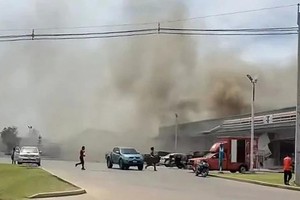
NEW ORLEANS, Louisiana (AFP) – BP said Friday it is considering cutting its dividend payments, as US officials more than doubled the estimated size of the Gulf of Mexico oil leak soiling fragile shores.
"We are considering all options on the dividend. But no decision has been made," BP chief executive Tony Hayward told The Wall Street Journal.
The newspaper said BP's board of directors may consider cutting or deferring its second-quarter dividend -- due to be announced on July 27 -- or even issuing dividend payments as scrip, effectively a means of delaying payment to shareholders.
President Barack Obama and US lawmakers have turned their sights in recent days on the regular BP dividend, a lucrative source of income for many US and British pension funds, even as the firm's shares continued to slump in the face of what is likely to be a multi-billion-dollar cleanup bill.
US criticism has especially centered on Hayward, who Obama suggested he would have fired by now if the executive were his employee. And BP's chairman has now been summoned to a White House meeting with Obama next week.
Data suggesting the oil's flow could be upwards of 40,000 barrels a day -- some 1.68 million gallons -- rounded off a miserable day for BP on Thursday in which its share price hit its lowest level since 1997 before closing down 6.7 percent.
Investors fled for fear Obama intends to exact a heavy price from the British energy giant as its potential liability soars and US officials look to suspend prized shareholder dividends until compensation is paid.
BP's share price has collapsed more than 40 percent -- wiping tens of billions of dollars off its market value -- since the Deepwater Horizon rig sank on April 22.
Friday could be worse as the markets had already closed by the time Marcia McNutt, chairing the US government's flow rate assessment team, doubled the previous official figures of between 12,000 and 19,000 barrels per day.
For angry Americans digesting daily images of oiled birds and crude-covered marshes, the latest estimates only reinforced the impression that BP has been disingenuous about the size of the spill from the start to try to limit its liability.
The company's first estimate was only 1,000 barrels per day and it stuck to a later estimate of 5,000 barrels a day even as that amount was being siphoned to the surface with more oil and natural gas still clearly gushing out.
A containment device fitted last week is now capturing 15,800 barrels a day, but the latest data suggests at least 4,200 barrels and possibly up to 25,000 barrels -- more than a million gallons -- are still spewing into the sea each day.
At least 40 million gallons of crude have already poured into the Gulf, and perhaps double that. That is roughly four times as much as the Exxon Valdez spill off the Alaskan coast in 1989.
Coast Guard Admiral Thad Allen, who is leading the US government's response to the crisis, summoned BP chairman Carl-Henric Svanberg and other company officials to a White House meeting next Wednesday.
But there was no word on whether Hayward would participate.
"The potential devastation to the Gulf Coast, its economy and its people require relentless efforts to stop the leak and contain the damage," Allen said in a letter to Svanberg.
Obama, who heads to the Gulf next week for his fourth visit since the disaster, met Thursday at the White House with relatives of the 11 workers killed when the Deepwater Horizon rig exploded.
The latest plunge in BP's share price came after US Interior Secretary Ken Salazar said the company's liability should include reimbursing all companies hit by a six-month moratorium on deep sea drilling.
US government officials said BP had agreed to speed up payouts to individuals and businesses affected by the spill following a meeting with Admiral Allen.
In an interview with AFP, Allen said BP had responded to a US government request for more information on its contingency planning for the containment system, and said he was satisfied by its response.
The imminent arrival of a second processing vessel is expected to boost the capacity of the containment system to 28,000 barrels and Allen said further operations would be carried out over the "next three to four weeks" to put down a new mooring at the site.
The mooring will allow a super tanker and more equipment to be brought in to place a more fitted cap on the leak that can capture all the leaking oil and make the system easier to disconnect in the event of a hurricane.
A permanent solution will not come before the first of two relief wells are drilled, in August at the earliest, allowing the leak to be plugged with cement.
























